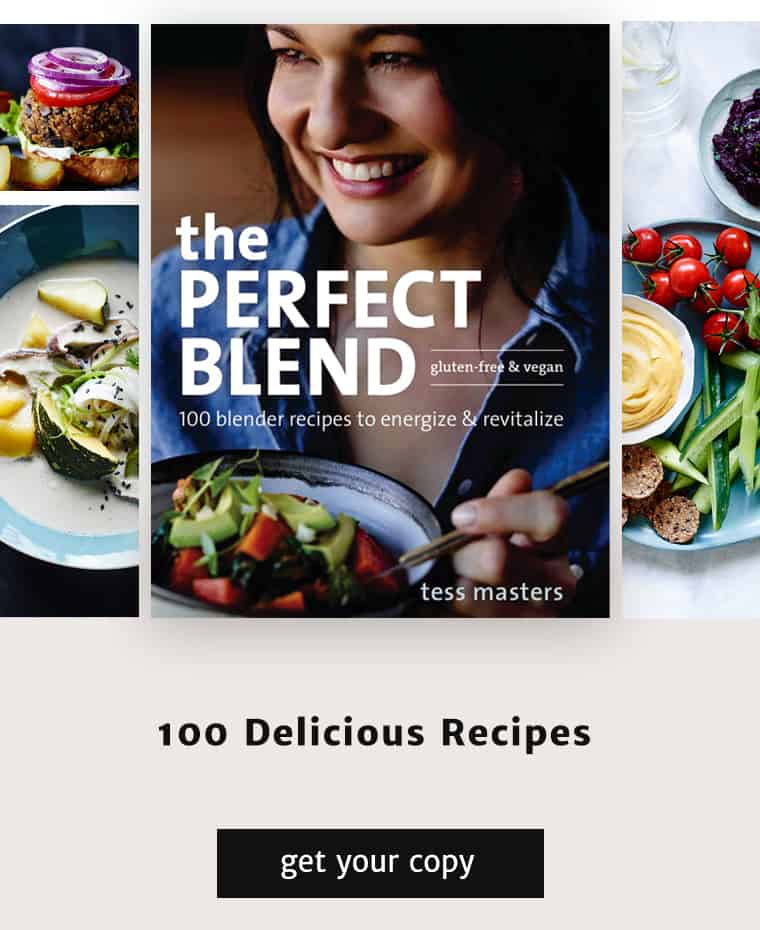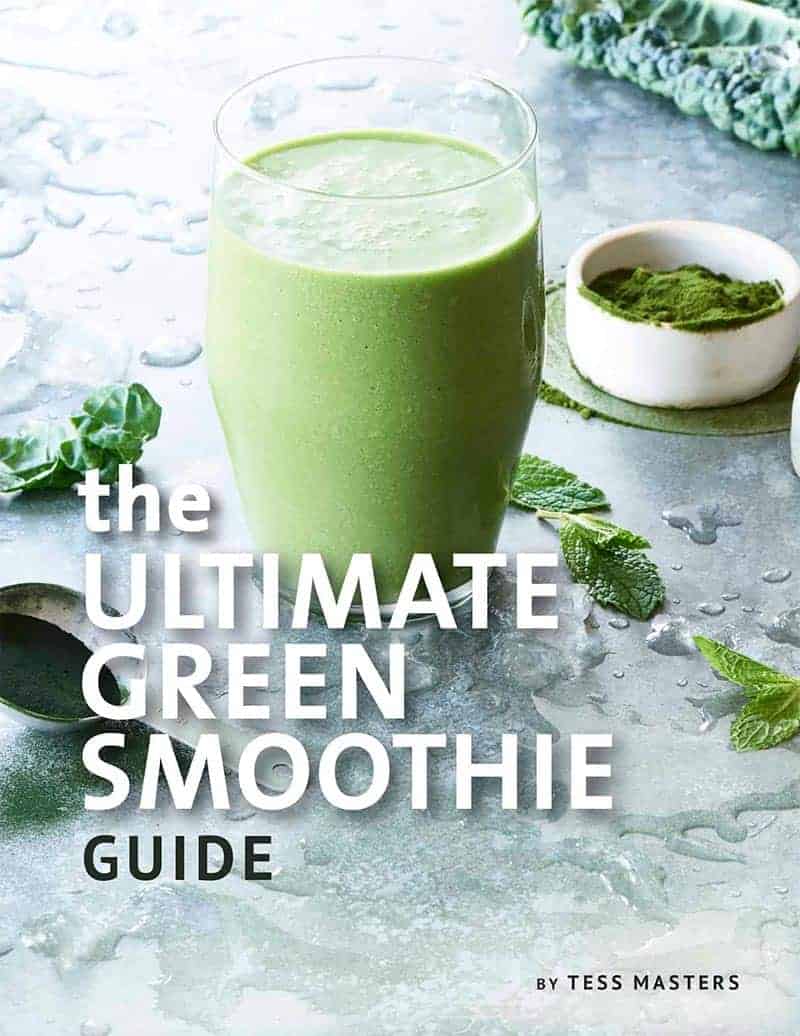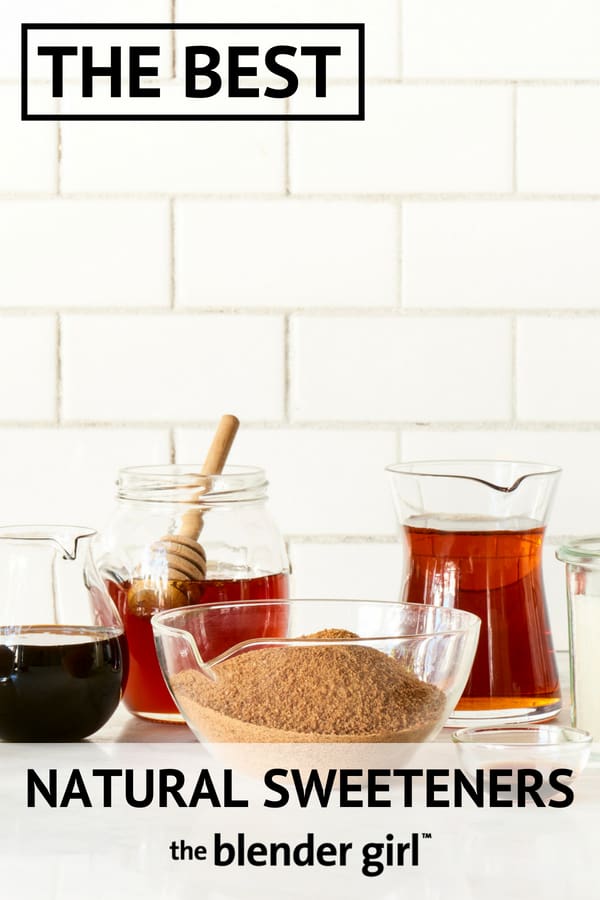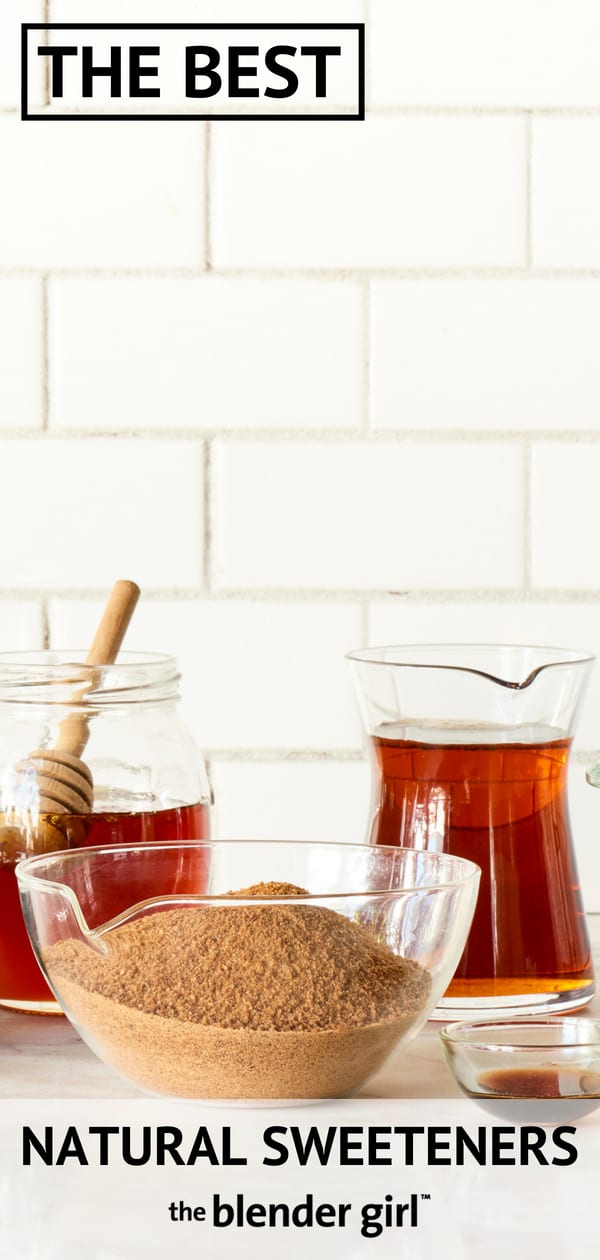Natural Sweeteners
What are the best natural sweeteners? Information on the types of natural sweeteners, and how to use sweeteners in healthy recipes.
A Guide To Natural Sweeteners
Choose natural sweeteners to fit the personality of your blend. If texture’s a concern, use a liquid sweetener. Combining sweeteners can yield great results.
With regards to substitutions, it is often best to swap a liquid sweetener for a liquid sweetener, granular for granular, and powder for powder.
Regardless of what swap you try, amounts may vary, and it may not be a 1:1 swap.
A prudent approach is to start small and add to taste.
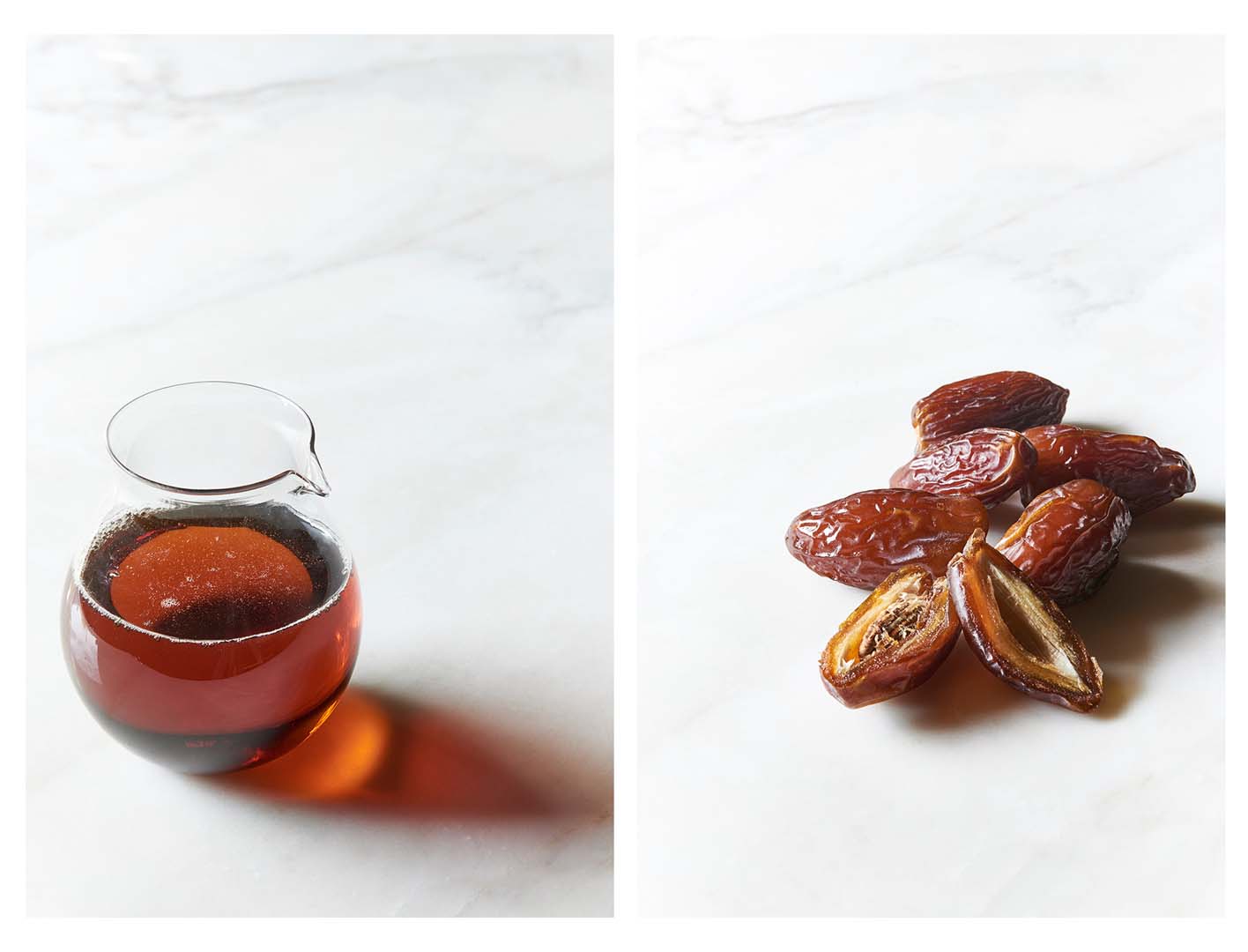
Maple Syrup
No, not the “maple flavoured” syrup found at your local breakfast joint, which is just a sad imitation made from corn syrup or refined sugar.
Pure 100% maple syrup is the boiled sap from the sugar, red or black maple tree, and might just be the nectar of the Gods, discovered by the North American Indians. This gorgeous viscous syrup of joy is rich in manganese and zinc, which assist with lowering cholesterol and improving heart health; as well as boosting antioxidants and supporting strong immunity.
Maple syrup comes in grades of A and B, and in light, medium and dark varieties. The grading system is a guide for colour and flavour, not quality or purity. The darker the colour, the stronger the flavour. Pure organic Grade B maple syrup is produced from the sap harvested later in the season.
I absolutely love the deep, rich earthy flavour, and use it in everything – oatmeal, smoothies, desserts, dressings, baked goods, and on top of ice cream and pancakes.
I use maple syrup in large quantities when I want that distinct maple, caramel flavour. The strong personality of maple syrup can overpower the natural flavour of the other ingredients. If this personality is not appropriate, it is best to use it as an accent sweetener with a few tablespoons to heighten other more neutral sweeteners.
I have had huge success substituting maple syrup for granulated sugar in recipes. Generally, use ½ cup of maple syrup for every cup of sugar, and then halve the other liquid in the recipe. Then add ¼ teaspoon of baking soda per cup of syrup used, and lower the oven temperature by about 25 F.
You can also use maple sugar, which is made by boiling maple syrup down even further and evaporating and crystallizing it. It is sold in pressed blocks or as a ground sugar powder. You can use ½ – ¾ cup of maple sugar for every cup of refined sugar in baked recipes. But I mainly use maple sugar as an accent sweetener or topping on baked goods. I also love to make gourmet nuts by rolling them in maple sugar, cinnamon, or chocolate! Maple sugar is fantastic, but quite expensive, and can be a bit overpowering in large quantities, so I won’t post recipes using it very often. But it is worth a mention if you want to be really decadent!
Try to purchase organic maple syrup wherever possible. Some would argue that all maple syrup could be considered organic as it is produced deep in the forest where no herbicides and pesticides are used. However, organic is more than just the absence of these things. There are more stringent guidelines for quality control and production practices.
Always purchase maple syrup in glass or tins. Store these original containers in the fridge for up to a year. Try not to purchase in plastic, because it allows air into the container, which compromises the quality. If you do purchase in plastic, or decanter from large bulk containers at the health food store, transfer the batch to a glass container and refrigerate.
Maple syrup can be expensive. Purchase in bulk and freeze maple syrup in glass jars. Just leave an inch at the top to allow for expansion. But I never do this, as I can always find a use for it! What can I say? I go mental for the maple!
Dates
Dates are of the oldest natural sweeteners in the world, dating back to ancient Egypt and Arabia. The date fruit has been a staple food in the Middle East for thousands of years, and is extremely popular in the West, for use in sweet treats and snacks.
Dates are rich in vitamins and minerals, loaded with natural fibres, and relatively low in calories (about 23). Dates contain twenty different kinds of amino acids, which aids with digestion and the easily assimilation of nutrients. They are quickly and easily digested, making them a fantastic snack and energy booster. They are a good source of potassium, which contributes to a healthy nervous system; and great for alleviating constipation.
Always purchase raw dates that have been sun dried. These have the most nutritional density with more Vitamin C. There are tons of different kinds of dates, which vary in sugar content and flavour. I like the Medjool variety, which is sweet, delicious, and the most widely available.
I use “raw” pitted dates a lot to bind and sweeten raw desserts and sweeten smoothies. For the smoothest results, soak the dates in a little bit of filtered water. This helps them incorporate more evenly into blends.
You can puree dates in your blender (you must have a high speed blender to do this) and make date paste, which is delicious in desserts. You can also dehydrate date paste to make date sugar, which has a phenomenal depth of flavour, to sprinkle on oats and other grains. Date sugar is very strong and doesn’t melt very well. I don’t tend to use it for baking.
I limit my intake of dates where possible, and reserve them for special raw treats, as they can cause a spike in my blood sugar levels.
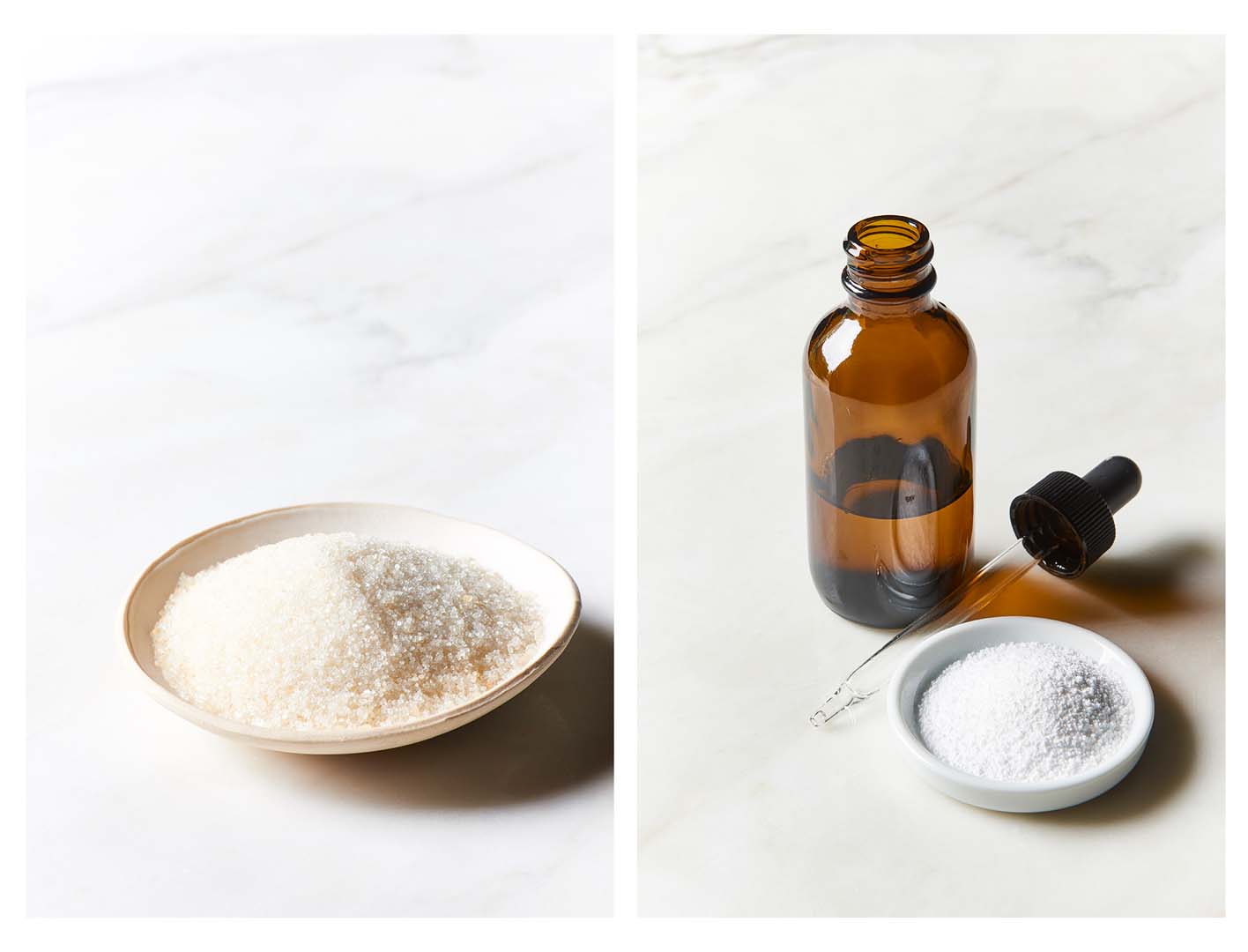
Stevia
Stevia is my everyday sweetener of choice and the healthiest natural sweetener.
Stevia is a herb found mainly in South America and China. The Japanese have been using Stevia since the 70’s to sweeten all kinds of processed foods like gum, drinks, desserts and many others with great success. It is heat stable so is ideal for cooking. Stevia is alkaline, calorie-free, does not contain any sucrose, and does not alter blood sugar levels, which makes it fantastic for diabetics, or people suffering from candida complexes.
Stevia comes in powder or liquid form, and is readily available at health food stores and grocery stores. Most stevia liquid is clear, but I prefer to use the dark, whole leaf concentrate that uses the whole leaf and water with a special cooking process that doesn’t contain any alcohol or chemicals. I normally buy the Sweet Leaf brand.
The best thing about Stevia? You only need a tiny amount, as it is about three hundred times sweeter than conventional sugars. A small bottle will last for months. Stevia is fantastic for sweetening tea and coffee, lifting the effect of other natural sweeteners. It can be a bit bitter on its own.
Pure stevia is not suitable in baked goods as they don’t rise. There are now stevia/sugar baking blends that are suitable for reducing the sugar content in baking.
I use stevia to sweeten juices and smoothies, and boost other natural sweeteners in my recipes. The Sweet Leaf alcohol-free sweet drops (my favourites are the Vanilla Creme, English Toffee, Chocolate, Orange, Lemon, and Plain) are absolutely fantastic for sugar-free and alkaline recipes.
But stevia is not just a natural sweetener. It is a powerful dietary supplement which has anti-fungal and anti-inflammatory properties. It helps to balance the pancreas, which in turn, aids digestion, regulates blood sugar levels, and increases energy.
Cane Sugars
I don’t use granulated cane sugars very much. I do use coconut sugar. But, I prefer to use stevia, birch xylitol, monk fruit, pure maple syrup, yacon syrup, coconut syrup, and brown rice syrup.
But, if you are going to use granulated cane sugars in baked goods and other recipes choose those that are minimally processed. Rapadura and Demerara sugars are good options.
The term “natural” when associated with cane sugars is quite controversial, as is the term “raw”.
Anything unrefined is commonly called raw. However, traditional raw foodists would claim that only those sugars that are processed at very low temperatures should be considered raw.
For my purposes, I am referring to any cane sugar that is unrefined, minimally processed, and not exposed to extreme temperatures.
When choosing cane sugars, I look for raw, whole, unrefined and unbleached sugars that most closely resemble the texture of brown sugar.
Labeling can be very inconsistent and misleading on a lot of sugar products. There are a wide variety of cane sugars such as Sucanat, Rapadura, Muscovado, Turbinado and Demerara sugars.
However, the quality of these products can vary considerably and it can be really confusing choosing the most appropriate sweetener for the needs of a specific recipe.
Like all of the other ingredients, knowledge comes from experience and experimentation. A sugar might be raw and whole, but will produce a really grainy texture that might not always be desirable. Raw sugars also have a higher moisture content than more refined sugars, and other ingredient quantities need to be tweaked in order to achieve the right balance when substituting.
It is helpful to understand how sugar is produced.
Sugarcane is a grass that grows in the tropics. To make granulated sugars, there are several processes that determine the personality of the sugar. Firstly, the sugar cane is cut and pressed to extract the sugar cane juice. This juice is then heated, cooled, dried, and crystallized.
Raw sugars are the process of this first stage of the sugar cane refining process, and the different characteristics are determined by the temperature and handling during this process. The sugar can form into large, molasses-rich granules that are crunchy and complex in flavor — perfect for topping pastries and pies.
Sugars with a finer texture with a lower molasses content are more suitable for incorporating into batters. Sugar can then be further refined to remove the molasses completely, which results in the brown and white refined sugars that are most familiar.
For general baking, rapadura sugar is a good choice. This is a whole food product made from the dried whole natural cane juice of the sugar cane. Unlike other raw cane sugars (like sucanat which is pure dehydrated cane juice that is heated at high temperatures and separated from the molasses stream during processing and then reblended), Rapadura sugar is never separated from its molasses content during pressing, and is evaporated over low heat, retaining all the vitamins and minerals available from sugar cane. It has a gorgeous golden color and rich caramel flavor. It dissolves and fairs well in most baked treats. I use about ¾ : 1 when substituting conventional refined sugars in recipes.
Turbinado sugar is a popular substitute for brown sugar or white refined sugar in baked recipes. It holds more moisture than refined sugars which can really improve the texture of gluten-free batters which are partial to being a little drier than conventional wheat-inspired batters. However, turbinado sugar is a lot more refined than rapadura sugar and does not have the rich nutritional profile. It has been heated and separated from the molasses content, and reblended, leaving the sugar crystals relatively bereft of any nutrients. If you don’t like the grainy texture of rapadura sugar you can grind it to a fine powder in your spice grinder or food processor, or in your blender in order to make it easier and more familiar to work with.
If I require a crunchy topping on cakes and muffins I like to use demerara sugar which has a gorgeous rich creamy molasses flavor that adds a sprinkle of magic to indulge in. Demerara sugar doesn’t dissolve during cooking and is not really suitable for batters unless you want a deliberate crunchy texture.
A lot of other sugars that are labeled as “raw” have been heated at high temperatures which removes a lot of the nutrients. It is also important to mention that “organic” does not equate to “raw” and “unprocessed”. I don’t touch these “refined raw sugars” or “white refined sugar”, which has been heated to extreme temperatures, boiled and dried until it is pure sucrose devoid of any nutrients. “Brown sugar” is also often mistaken for raw sugar. Brown sugar is simply white refined sugar that has been blended with molasses.
Stick with the more complex unrefined sugars like Rapadura sugar. They have a more impressive nutritional profile and a superior flavor.
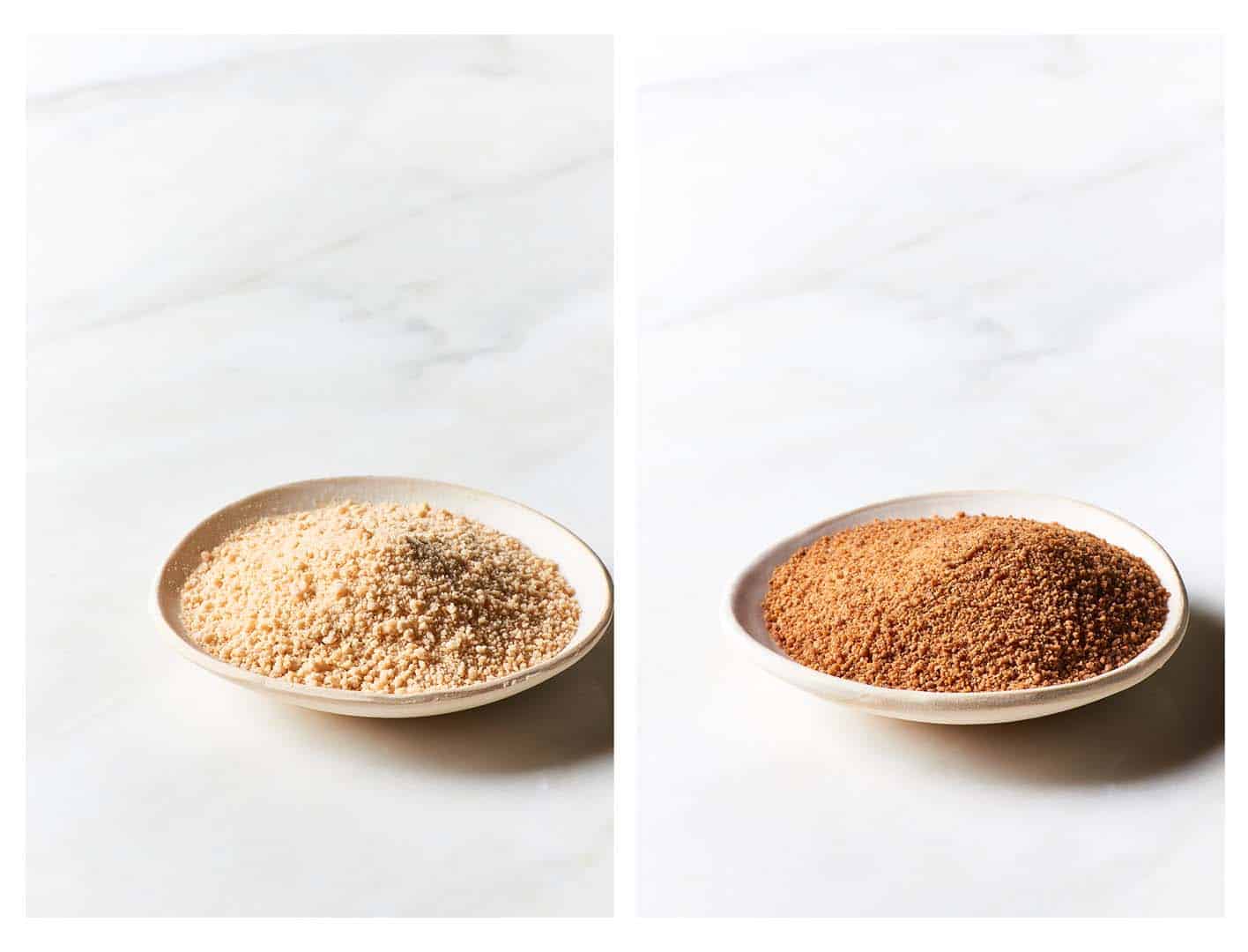
Coconut Sugar
Coconut sugar is a good low GI sugar substitute. It is particularly useful if you want a rich toffee flavor. It looks like brown sugar, but it is much more nutritionally dense. Coconut sugar contains iron, magnesium, and zinc, as well as vitamins B1, B2. B3 and B6.
Coconut sugar is made by collecting the nectar from coconut-palm sugar blossoms. This nectar is then boiled in kettles, which reduces the moisture, and allows solidification. The solid mass is then cooled, crystallized, and granulated. Coconut sugar is relatively low GI (about 35), and is a fantastic substitute for brown or white refined sugars. I have used it with great success in tons of raw and cooked desserts.
Substituting coconut sugar for other granulated sugars is easy. I have found using a straight 1:1 ratio substitution works really well. In fact, it is so powerful that you can even reduce the quantity to ¾, which mellows out the flavors, and is a little kinder on the purse strings.
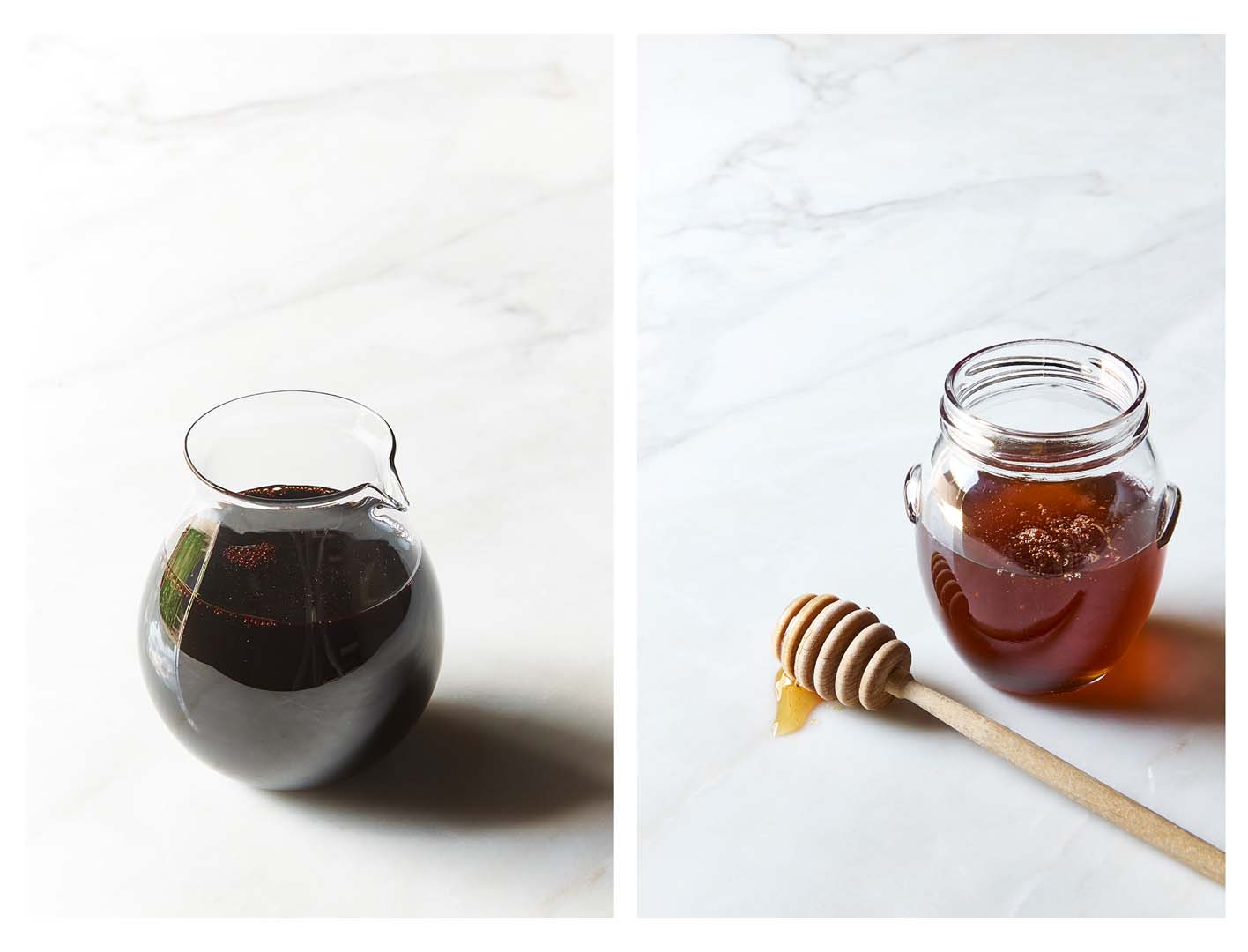
Honey
I am a vegan. However, honey has been used in a few early recipes on the site. I also get asked a lot about substituting honey in the recipes.
Local, raw, organic honey has incredible health promoting properties.
Organic honey is rich in nutrients such as C, D E and B Complex; is loaded with essential amino acids; and has powerful antimicrobial and antioxidant properties. I prefer raw, unfiltered honey, which contains bee pollen, which is rich in protein. Raw honey also contains Propolis or “bee glue” which is anti-viral, anti-fungal, and anti-bacterial. Propolis also contains powerful phytonutrients which have anti-cancer benefits.
Raw organic honey contains beneficial lactobacillus and bifidus bacteria, and can assist with maintaining healthy blood sugar levels. Superior quality honey also has incredible healing properties if applied to burns, ulcers, and other wounds. If you burn yourself, slather some Manuka honey on!
Most honey on the market have been heated, filtered and processed compromising the integrity of the nutritional panel. So, purchase raw honey wherever possible.
Honey comes in a variety of colors from opague, to amber, red, brown and black. The color, flavor, and texture is dependent on the flower the bees have bred on. Common varieties are made from clover, acacia, and alfalfa.
My favorite honey is the rich decadent raw unprocessed Manuka honey from New Zealand, which has powerful medicinal properties and stringent regulations not found in other honeys.
I try not to use honey in large quantities, as it is much sweeter than conventional sugar, and is absorbed directly into the bloodstream.
Unless you want a prominent honey flavor profile, it is best use it as an accent sweetener.
As a general rule, I do not like to heat honey as it gets more assertive in flavor. Generally, mild-flavored honeys, such as clover, are best for cooking, so the flavor doesn’t dominate.
When using organic honey as a substitute for granulated sugars, use the same amount, but reduce the liquid in the recipe by one quarter, and lower the oven temperature by about 15 C / 60 F.
To measure honey, use measuring cups and spoons that have been dipped in hot water. Then the honey will easily slide off.
Always store honey at room temperature. If it crystallizes, take the lid off and place the container in a bowl of warm water until the crystals dissolve.
Purchase local honey wherever possible. This has been produced by bees pollinating on the plants in your local area. Consumption and topical application of raw local honey can help enormously with air-borne allergies. I have applied it to my eyelids and around my eyes during hay fever season and it was like magic. My allergies disappeared.
Blackstrap Molasses
Crude unsulphured blackstrap molasses is the only sugar that is alkaline-forming due to its rich mineral profile. Molasses is a thick, black, viscous syrup with a robust bittersweet taste, that is made from boiling sugar cane.
Blackstrap molasses is graded much like maple syrup, according to how many times it has been boiled. Blackstrap molasses has the highest grade. It has been boiled three times, and is extremely concentrated. The great news? This is a sweetener that is actually good for us!
Unlike most sweeteners that offer empty calories, crude blackstrap molasses is nutrient-rich and fat free! It is a great source of iron and calcium, as well as copper, manganese, potassium and magnesium. Just a couple of teaspoons a day in your porridge or tea, and you can quickly grab over 10% of all of these essentials for healthy bones, teeth, heart and colon health, and digestion; just to name a few.
Always purchase the crude unsulphured variety made from organic sugar cane. Those of you with food allergies may be sensitive to sulphur; and chemical processing isn’t good for any of us.
Unsulphured molasses is also more clarified and tastes better. I use this natural sweetener in rich desserts where I want that distinct robust flavor. It is traditionally used in gingerbread recipes. But fairs well in other cookies and cakes, and is great to add to raw and cooked granola. I also love to use it in to make BBQ sauce.
Always store molasses in a sealed container in a cool dark place. An unopened jar will keep for about a year. Once it has been opened, you have got about six months.
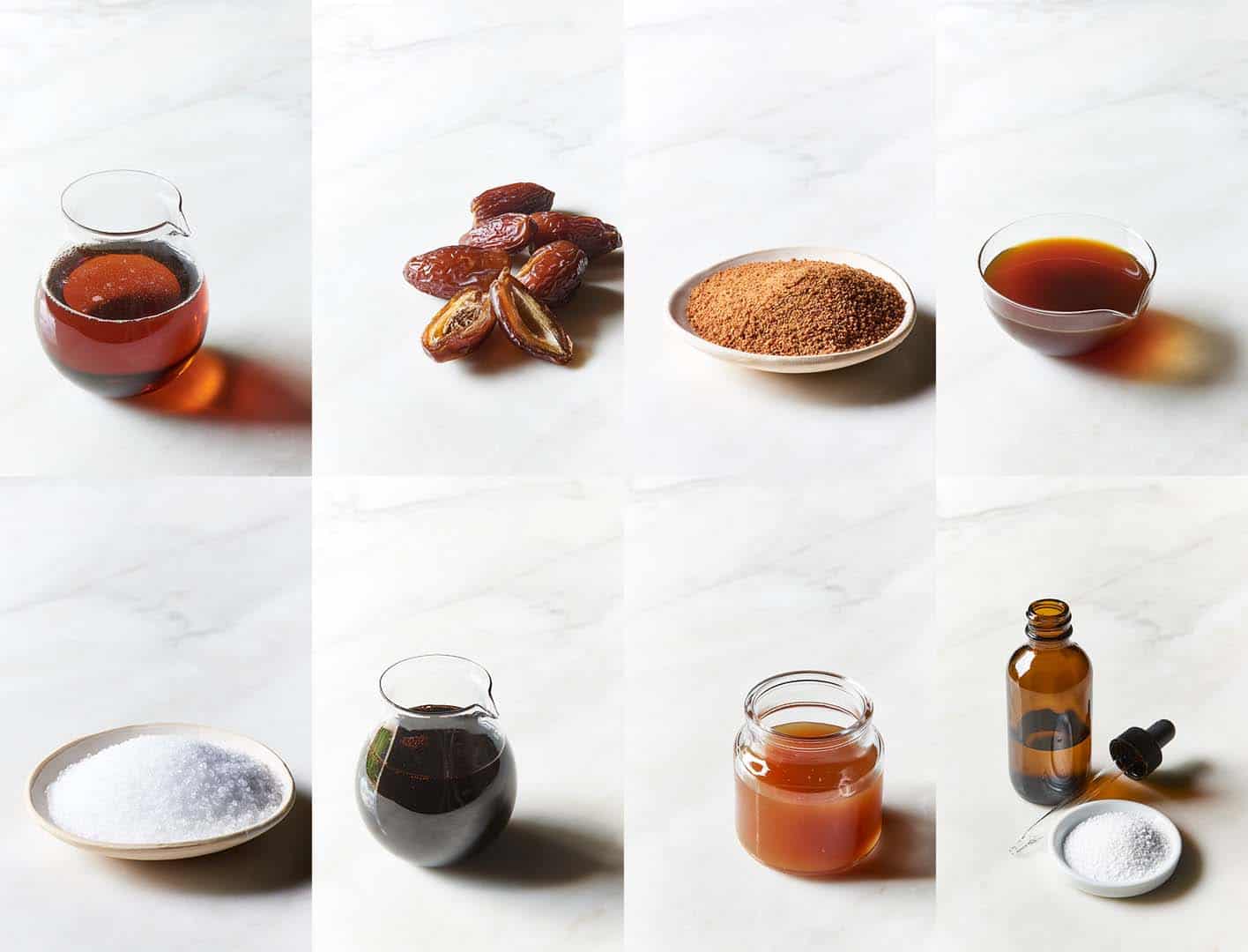
Fruit Juice and Concentrate
I am a huge fan of using fresh extracted organic fruit juice to sweeten blended treats. I most often use orange, apple, pineapple and pear juice as they blend in with other flavors in a subtle way.
Fruit juice concentrates are convenient to have in the pantry for times when you don’t have enough fresh fruit.
I often heighten the sweetness of the fruit and concentrate with other natural sweeteners in order to yield the most balanced flavor profile.
Yacon Syrup
Yacon was first used by the Incas, and is now a product out of Peru where the Yacon root, (native to the Andes and a distant relative of the sunflower), is dried in the sun, and made into a syrup, which is typically not heated above 40 C/ 104 F making it a popular raw sweetener.
Yacon syrup is dark brown in color, and has a full bodied taste similar to molasses, caramelized sugar, or honey; making it a great substitute when a deep rich flavor is desired. The sweetness of dried yacon root comes from the high component of Fructooligosaccharides(of FOS).
The body does not have enzymes to process and metabolize FOS, and so it passes through the digestive system without leaving absorbable or stored sugar compounds.
This natural sweetener has long been thought to have medicinal properties. The Peruvians cut it up in their dishes to aid health; and in Brazil, it has been used to combat diabetes. Yacon is rich in iron and potassium, and contains antioxidant vitamins to combat viruses and bacteria.
The indigestible part, of this insulin-derived sweetener, serves as a prebiotic, supporting healthy digestion by assisting to colonize beneficial bacteria in the colon, and boosting immunity; making it great in small quantities for people susceptible to candida overgrowth.
Furthermore, the natural oligofructose contained in the yacon makes it a warrior against osteoporosis, aiding the absorption of calcium and magnesium and increasing bone density.
Because the FOS cannot be absorbed, and the other natural sugars are slowly absorbed, yacon rates low on the glycemic index. It is lower than agave, is glucose free, and relatively low in calories — containing less calories than potato and sweet potato, and half the calories of honey, making it a great sugar substitute for diabetics and vegans. However, people with allergies to fructose should be aware that it may trigger fructose malabsorption, and other health effects of fructose.
Yacon is a good natural sweetener for people avoiding agave nectar. It has a lower glycemic index, is lower in calories, However, it is not as versatile as agave as it has a much more distinctive flavor. It is lot more powerful than honey, and is best substituted for molasses or brown sugar in baked goods.
I don’t tend to bake a lot with this sweetener, unless I want that prominent flavor. Having said that, it is delicious in gingerbread; and is gorgeous with chocolates and nuts. But I find it is best used as an accent sweetener in raw puddings and smoothies.
With yacon syrup, you usually only need a tablespoon or two. I also love to drizzle it on my oats and other grains, or to sweeten the deal with curries and stews.
The only draw back to yacon syrup is that is not as widely available yet, and is really expensive. Try a tiny bit in your herbal tea. It is absolutely delicious, and a little goes a long way.
Agave Nectar
I did use agave in the earlier recipes on the site from 2010 to 2013, and agave us used in some recipes in my first cookbook.
I used agave a little bit before I learnt more about the drawbacks. Since researching further. I have not used agave nectar since 2013, and do not recommend it as a health sweetener as it has an unbalanced glucose/fructose profile.
I get asked about agave a lot. So, here's my take:
Commercial agave nectar is definitely not created equal, and depending on the processing, can yield a product that is from 56% fructose and 20% glucose, up to a whopping 92% fructose and 8% glucose, which is not at all desirable.
Agave is produced by filtering and heating the juice of the core of the agave cactus. This yields a liquid that tastes similar to honey, but is actually sweeter, with a thinner consistency that is less viscous.
There has been a lot of controversy surrounding agave nectar. Dr Mercola wrote a scathing article back in March 2010, comparing these high fructose unnatural varieties of agave to anti-freeze; and claimed they were more damaging than high fructose corn syrup. Phrases like “most brands” and “nearly all producers” were used.
Due to the media frenzy his article caused, he then wrote a follow-up article, where he clarified his position about fructose consumption (limit it to 25 gms a day and consume in moderation) and had three brands (Now, Madhava and Wholesome Sweetener) independently tested at a laboratory. This test showed showed that all of those brands did, indeed, contain high levels of fructose.
Agave nectar contains more fructose than other natural sweeteners, consisting of mainly fructose and glucose, and whilst it has a similar low glycemic index as fructose, those of you with fructose issues or fructose allergies, and those with diabetes should be aware that the high fructose levels in agave nectar can cause issues such as glucose intolerance, fructose malabsorption and metabolic syndrome. Excessive fructose consumption can have detrimental effects on our health.
I will let you decide whether agave is a responsible choice (if consumed in moderation) for you and your family.
If you are going to use agave in sweet treats, think of it like this: vegetable oils are produced by cold pressing or hydrogenation; the latter being damaging, whilst the former can be incredibly beneficial for health. Raw agave is a healthier alternative with a much better nutritional profile, containing iron, calcium, potassium and magnesium. Raw agave has a light neutral taste similar to the boiled light variety, but has not been heated above 48 C / 118 F, leaving the natural enzymes available, yielding a product that is closer to 50% fructose that is bonded to other sugars. So, this is the best agave to use if you are going to use it in raw recipes.
When using agave, a 1:1 ratio works for most recipes and hold back some of the other liquid ingredients. Also, reduce the oven temperature a little.
Agave is sold in light, amber, dark and raw varieties, that are indicative of the level of processing. The light agave has the most neutral flavor, and most closely resembles conventional sugars in baked goods. The amber variety has a more intense flavor and is best for recipes that benefit from a caramel flavor. Dark agave has an even more distinct caramel flavor.
Pomegranate Molasses
Pomegranate molasses is made by boiling down the juice of very tart pomegranates. The result is a thick, dark brown, maroon, or purplish liquid with a tangy, fruity, sweet taste, that is very distinct, and has traditionally been used as a flavor enhancer in Middle Eastern savory and sweet dishes.
The antioxidant power of pomegranates is well documented. But pomegranate molasses largely remains a gourmet delicacy in the West.
It is not as widely available as some of the other natural sweeteners. But you can find it at exotic food stores, ethnic grocers, and online.


